Effective Team Working and Communication: A Nursing Perspective
VerifiedAdded on 2023/01/09
|11
|3036
|45
Essay
AI Summary
This essay delves into the critical aspects of effective team working and communication within the healthcare environment, drawing upon the author's personal experiences and observations. The paper highlights the significant impact of employer communication styles on employee morale, job satisfaction, and overall productivity. Through specific examples, the author illustrates how poor communication, lack of clarity in instructions, and inadequate leadership can negatively affect team performance and create dissatisfaction. The essay also addresses the challenges posed by cultural diversity in the workplace and the importance of inclusive communication strategies. Furthermore, it examines how the involvement of employees in decision-making processes and the adoption of transformative leadership styles can foster a more positive and productive work environment. The paper concludes by providing practical recommendations for improving workplace communication, including continuous quality improvement, active listening, and the use of feedback mechanisms to enhance team cohesion and achieve organizational goals.
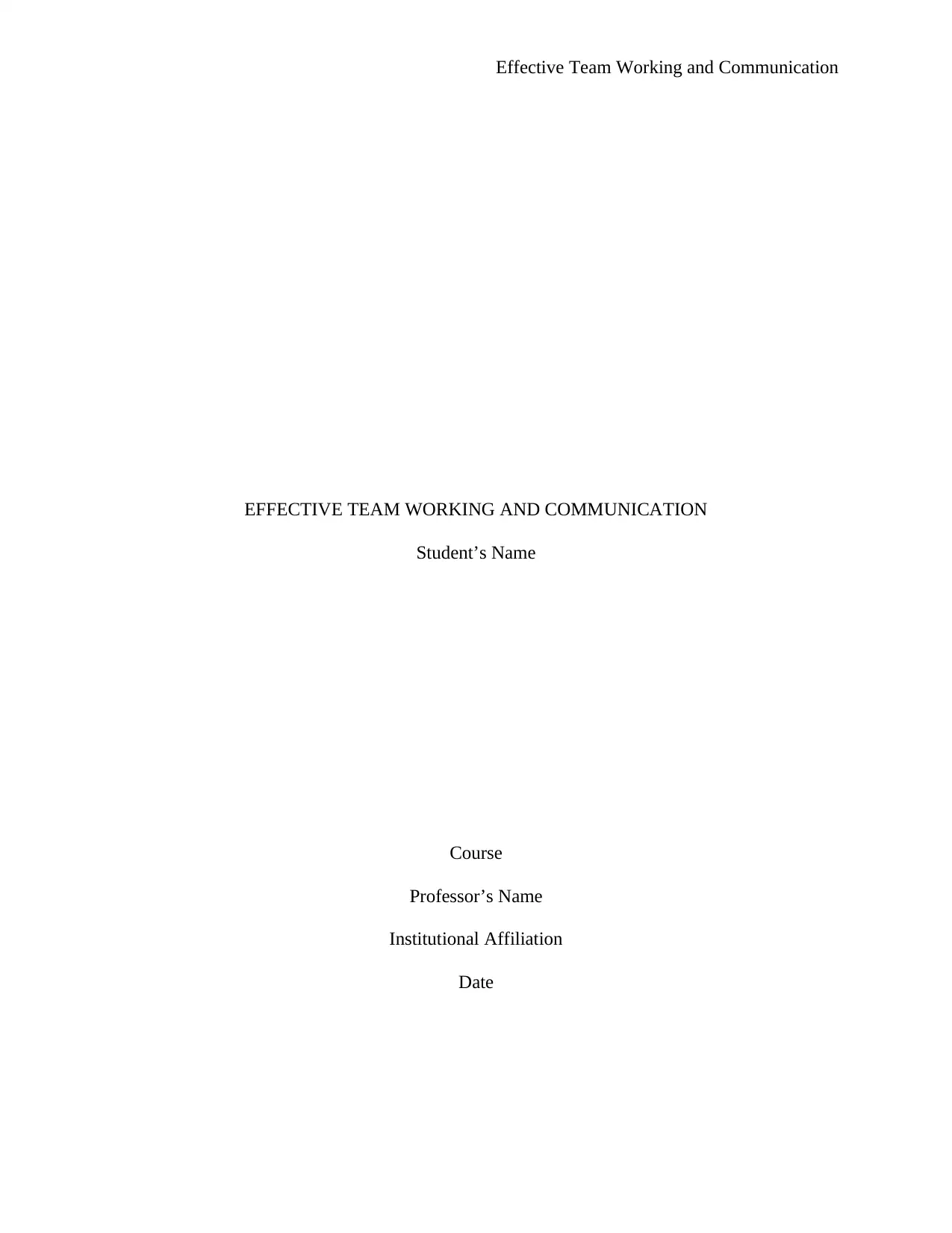
Effective Team Working and Communication
EFFECTIVE TEAM WORKING AND COMMUNICATION
Student’s Name
Course
Professor’s Name
Institutional Affiliation
Date
EFFECTIVE TEAM WORKING AND COMMUNICATION
Student’s Name
Course
Professor’s Name
Institutional Affiliation
Date
Paraphrase This Document
Need a fresh take? Get an instant paraphrase of this document with our AI Paraphraser
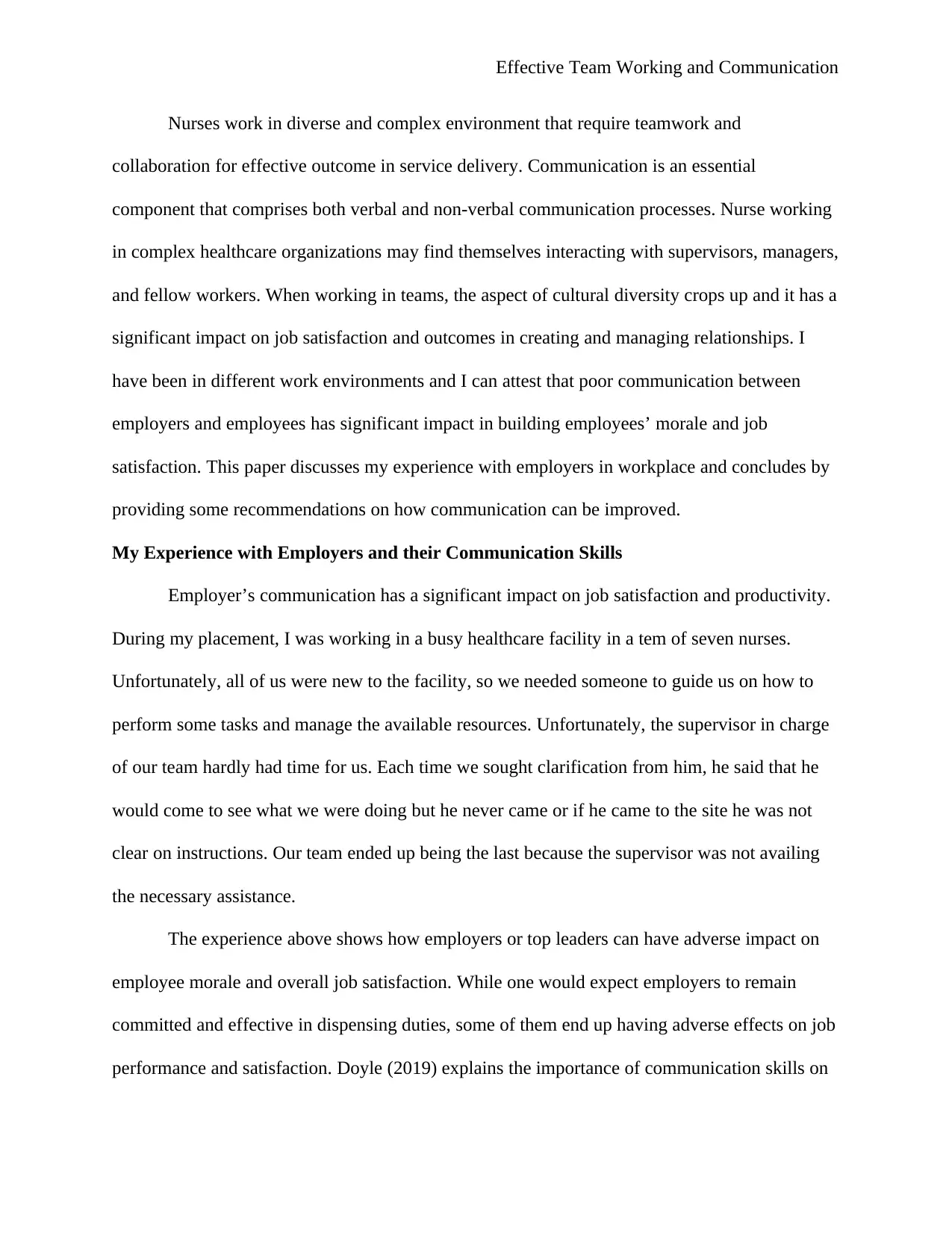
Effective Team Working and Communication
Nurses work in diverse and complex environment that require teamwork and
collaboration for effective outcome in service delivery. Communication is an essential
component that comprises both verbal and non-verbal communication processes. Nurse working
in complex healthcare organizations may find themselves interacting with supervisors, managers,
and fellow workers. When working in teams, the aspect of cultural diversity crops up and it has a
significant impact on job satisfaction and outcomes in creating and managing relationships. I
have been in different work environments and I can attest that poor communication between
employers and employees has significant impact in building employees’ morale and job
satisfaction. This paper discusses my experience with employers in workplace and concludes by
providing some recommendations on how communication can be improved.
My Experience with Employers and their Communication Skills
Employer’s communication has a significant impact on job satisfaction and productivity.
During my placement, I was working in a busy healthcare facility in a tem of seven nurses.
Unfortunately, all of us were new to the facility, so we needed someone to guide us on how to
perform some tasks and manage the available resources. Unfortunately, the supervisor in charge
of our team hardly had time for us. Each time we sought clarification from him, he said that he
would come to see what we were doing but he never came or if he came to the site he was not
clear on instructions. Our team ended up being the last because the supervisor was not availing
the necessary assistance.
The experience above shows how employers or top leaders can have adverse impact on
employee morale and overall job satisfaction. While one would expect employers to remain
committed and effective in dispensing duties, some of them end up having adverse effects on job
performance and satisfaction. Doyle (2019) explains the importance of communication skills on
Nurses work in diverse and complex environment that require teamwork and
collaboration for effective outcome in service delivery. Communication is an essential
component that comprises both verbal and non-verbal communication processes. Nurse working
in complex healthcare organizations may find themselves interacting with supervisors, managers,
and fellow workers. When working in teams, the aspect of cultural diversity crops up and it has a
significant impact on job satisfaction and outcomes in creating and managing relationships. I
have been in different work environments and I can attest that poor communication between
employers and employees has significant impact in building employees’ morale and job
satisfaction. This paper discusses my experience with employers in workplace and concludes by
providing some recommendations on how communication can be improved.
My Experience with Employers and their Communication Skills
Employer’s communication has a significant impact on job satisfaction and productivity.
During my placement, I was working in a busy healthcare facility in a tem of seven nurses.
Unfortunately, all of us were new to the facility, so we needed someone to guide us on how to
perform some tasks and manage the available resources. Unfortunately, the supervisor in charge
of our team hardly had time for us. Each time we sought clarification from him, he said that he
would come to see what we were doing but he never came or if he came to the site he was not
clear on instructions. Our team ended up being the last because the supervisor was not availing
the necessary assistance.
The experience above shows how employers or top leaders can have adverse impact on
employee morale and overall job satisfaction. While one would expect employers to remain
committed and effective in dispensing duties, some of them end up having adverse effects on job
performance and satisfaction. Doyle (2019) explains the importance of communication skills on

Effective Team Working and Communication
job performance and satisfaction from the employee’s point of view. Communication is not just
giving instructions, but it entails how the instructions are given. Communication strategies and
abilities are responsible for initiating and creating binding relationships between employers and
their subordinates. BergmanDellve, and Skagert (2016) explain that employers that provide clear
communication reduce conflicts in workplaces and create lasting bond between employees and
employers.
One of the factors that affect communication in workplaces is the problem of diversity. In
today’s globalized era, employers come across employees from diverse backgrounds. Some
organizations are likely to employ supervisors and managers from different cultures who hardly
understand the cultures of their workers. Companies going global often face challenges in
meeting the expectations of the local communities because of cultural differences that diminish
the effectiveness of communication. Nevertheless, Boyen (2016) explains that communication
plays a significant role in forging and binding relationships, even when people are of diverse
cultures. Good managers are ready to appreciate cultural differences and diversities with the goal
of working to keep employees connected to the mission of the organization (Weyers, Jemi,
Karger, Raski, Rotthoff, Pentzek, &Mortsiefer, 2016). As a result, the exchange of information
between the employer and the employee has to occur in a formal manner that encourages
collaboration.
During one of my attachments, the organization decided to introduce retired nurses to
blend the current nurses because of shortage of nurses in the intensive care units. While everyone
had anticipated that this could lead to improved service delivery and reduce work overload on
existing nurses, the decision attracted opposition and rejection from the existing team and they
even threatened to lay down tools because they felt that their employer was planning to terminate
job performance and satisfaction from the employee’s point of view. Communication is not just
giving instructions, but it entails how the instructions are given. Communication strategies and
abilities are responsible for initiating and creating binding relationships between employers and
their subordinates. BergmanDellve, and Skagert (2016) explain that employers that provide clear
communication reduce conflicts in workplaces and create lasting bond between employees and
employers.
One of the factors that affect communication in workplaces is the problem of diversity. In
today’s globalized era, employers come across employees from diverse backgrounds. Some
organizations are likely to employ supervisors and managers from different cultures who hardly
understand the cultures of their workers. Companies going global often face challenges in
meeting the expectations of the local communities because of cultural differences that diminish
the effectiveness of communication. Nevertheless, Boyen (2016) explains that communication
plays a significant role in forging and binding relationships, even when people are of diverse
cultures. Good managers are ready to appreciate cultural differences and diversities with the goal
of working to keep employees connected to the mission of the organization (Weyers, Jemi,
Karger, Raski, Rotthoff, Pentzek, &Mortsiefer, 2016). As a result, the exchange of information
between the employer and the employee has to occur in a formal manner that encourages
collaboration.
During one of my attachments, the organization decided to introduce retired nurses to
blend the current nurses because of shortage of nurses in the intensive care units. While everyone
had anticipated that this could lead to improved service delivery and reduce work overload on
existing nurses, the decision attracted opposition and rejection from the existing team and they
even threatened to lay down tools because they felt that their employer was planning to terminate
⊘ This is a preview!⊘
Do you want full access?
Subscribe today to unlock all pages.

Trusted by 1+ million students worldwide
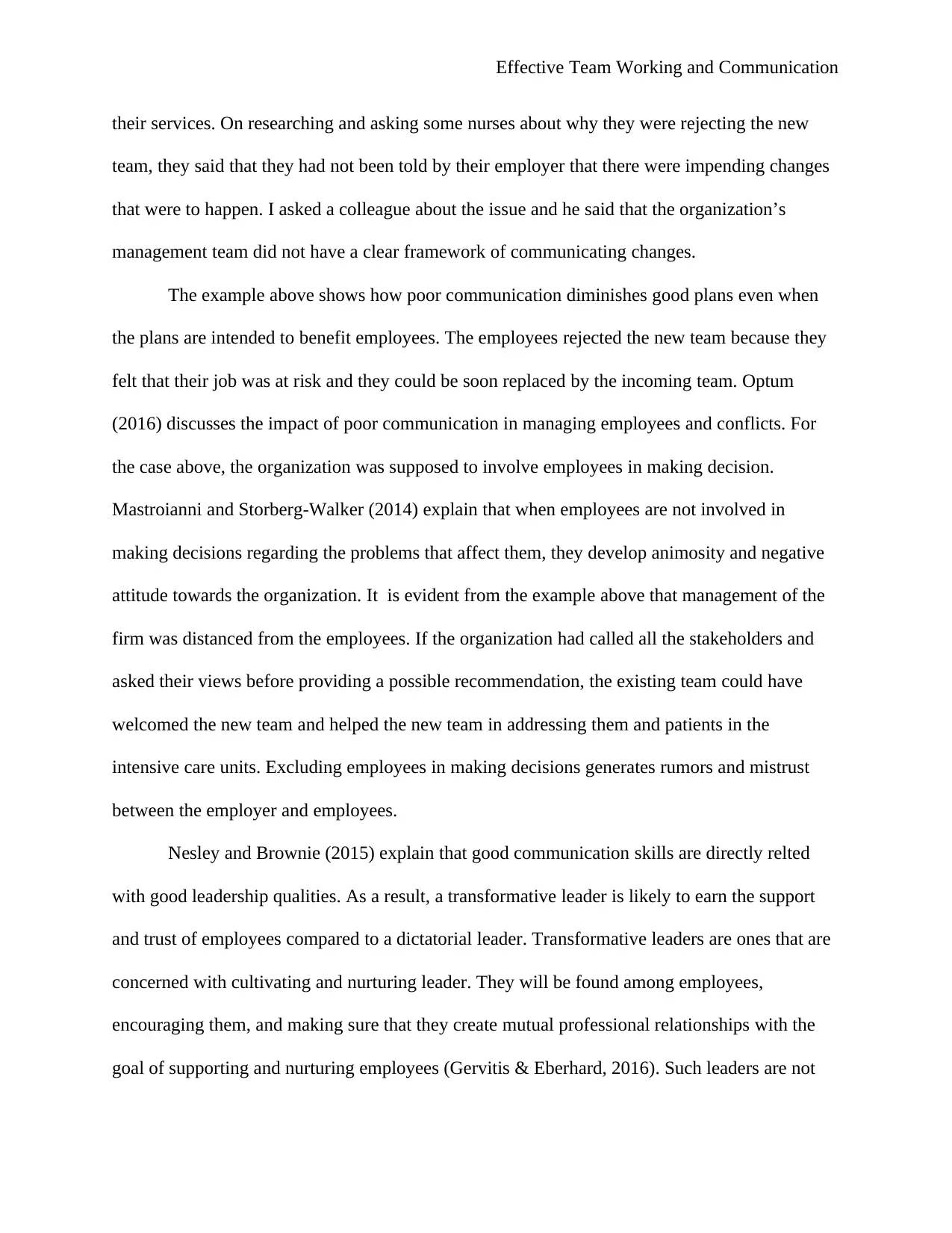
Effective Team Working and Communication
their services. On researching and asking some nurses about why they were rejecting the new
team, they said that they had not been told by their employer that there were impending changes
that were to happen. I asked a colleague about the issue and he said that the organization’s
management team did not have a clear framework of communicating changes.
The example above shows how poor communication diminishes good plans even when
the plans are intended to benefit employees. The employees rejected the new team because they
felt that their job was at risk and they could be soon replaced by the incoming team. Optum
(2016) discusses the impact of poor communication in managing employees and conflicts. For
the case above, the organization was supposed to involve employees in making decision.
Mastroianni and Storberg-Walker (2014) explain that when employees are not involved in
making decisions regarding the problems that affect them, they develop animosity and negative
attitude towards the organization. It is evident from the example above that management of the
firm was distanced from the employees. If the organization had called all the stakeholders and
asked their views before providing a possible recommendation, the existing team could have
welcomed the new team and helped the new team in addressing them and patients in the
intensive care units. Excluding employees in making decisions generates rumors and mistrust
between the employer and employees.
Nesley and Brownie (2015) explain that good communication skills are directly relted
with good leadership qualities. As a result, a transformative leader is likely to earn the support
and trust of employees compared to a dictatorial leader. Transformative leaders are ones that are
concerned with cultivating and nurturing leader. They will be found among employees,
encouraging them, and making sure that they create mutual professional relationships with the
goal of supporting and nurturing employees (Gervitis & Eberhard, 2016). Such leaders are not
their services. On researching and asking some nurses about why they were rejecting the new
team, they said that they had not been told by their employer that there were impending changes
that were to happen. I asked a colleague about the issue and he said that the organization’s
management team did not have a clear framework of communicating changes.
The example above shows how poor communication diminishes good plans even when
the plans are intended to benefit employees. The employees rejected the new team because they
felt that their job was at risk and they could be soon replaced by the incoming team. Optum
(2016) discusses the impact of poor communication in managing employees and conflicts. For
the case above, the organization was supposed to involve employees in making decision.
Mastroianni and Storberg-Walker (2014) explain that when employees are not involved in
making decisions regarding the problems that affect them, they develop animosity and negative
attitude towards the organization. It is evident from the example above that management of the
firm was distanced from the employees. If the organization had called all the stakeholders and
asked their views before providing a possible recommendation, the existing team could have
welcomed the new team and helped the new team in addressing them and patients in the
intensive care units. Excluding employees in making decisions generates rumors and mistrust
between the employer and employees.
Nesley and Brownie (2015) explain that good communication skills are directly relted
with good leadership qualities. As a result, a transformative leader is likely to earn the support
and trust of employees compared to a dictatorial leader. Transformative leaders are ones that are
concerned with cultivating and nurturing leader. They will be found among employees,
encouraging them, and making sure that they create mutual professional relationships with the
goal of supporting and nurturing employees (Gervitis & Eberhard, 2016). Such leaders are not
Paraphrase This Document
Need a fresh take? Get an instant paraphrase of this document with our AI Paraphraser
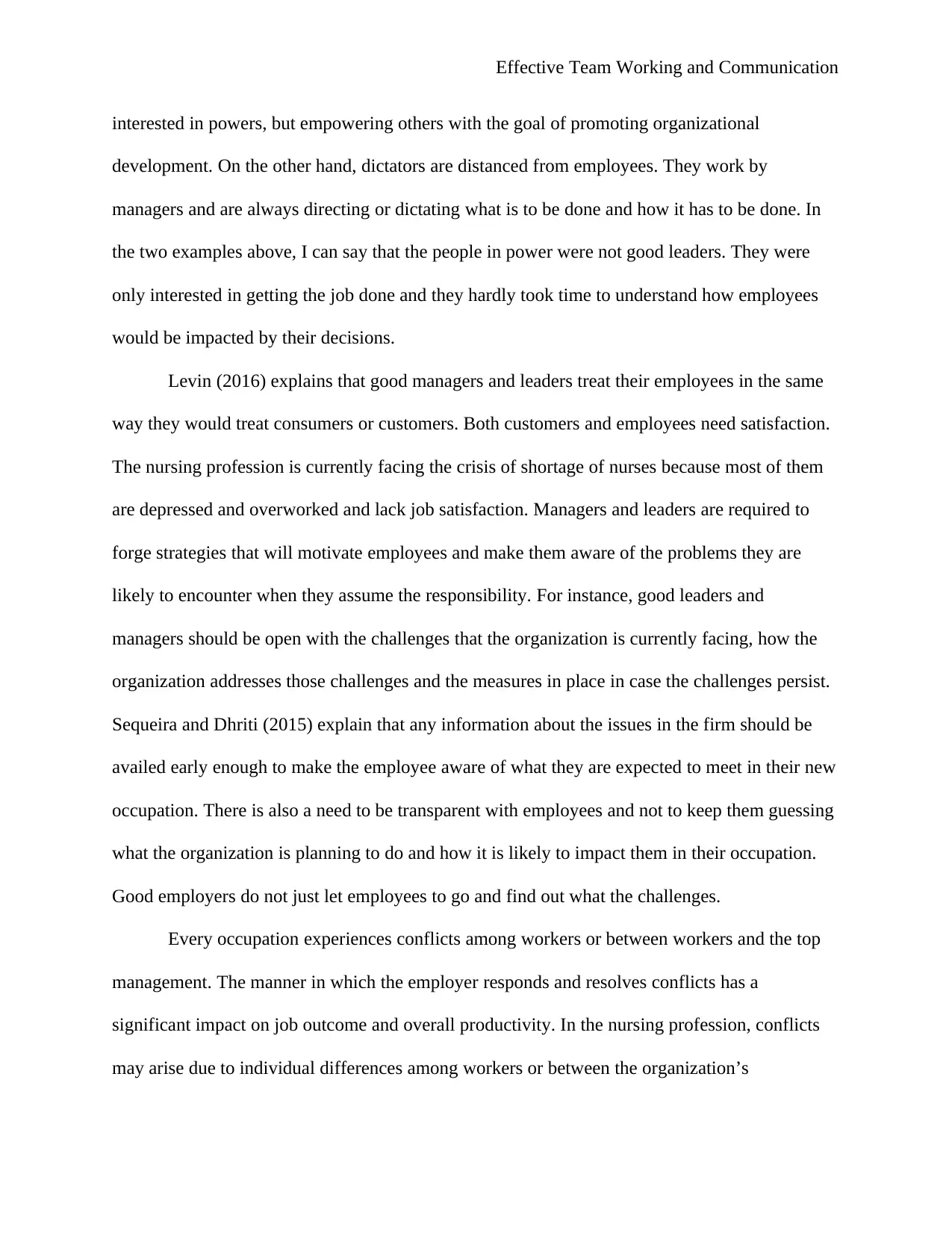
Effective Team Working and Communication
interested in powers, but empowering others with the goal of promoting organizational
development. On the other hand, dictators are distanced from employees. They work by
managers and are always directing or dictating what is to be done and how it has to be done. In
the two examples above, I can say that the people in power were not good leaders. They were
only interested in getting the job done and they hardly took time to understand how employees
would be impacted by their decisions.
Levin (2016) explains that good managers and leaders treat their employees in the same
way they would treat consumers or customers. Both customers and employees need satisfaction.
The nursing profession is currently facing the crisis of shortage of nurses because most of them
are depressed and overworked and lack job satisfaction. Managers and leaders are required to
forge strategies that will motivate employees and make them aware of the problems they are
likely to encounter when they assume the responsibility. For instance, good leaders and
managers should be open with the challenges that the organization is currently facing, how the
organization addresses those challenges and the measures in place in case the challenges persist.
Sequeira and Dhriti (2015) explain that any information about the issues in the firm should be
availed early enough to make the employee aware of what they are expected to meet in their new
occupation. There is also a need to be transparent with employees and not to keep them guessing
what the organization is planning to do and how it is likely to impact them in their occupation.
Good employers do not just let employees to go and find out what the challenges.
Every occupation experiences conflicts among workers or between workers and the top
management. The manner in which the employer responds and resolves conflicts has a
significant impact on job outcome and overall productivity. In the nursing profession, conflicts
may arise due to individual differences among workers or between the organization’s
interested in powers, but empowering others with the goal of promoting organizational
development. On the other hand, dictators are distanced from employees. They work by
managers and are always directing or dictating what is to be done and how it has to be done. In
the two examples above, I can say that the people in power were not good leaders. They were
only interested in getting the job done and they hardly took time to understand how employees
would be impacted by their decisions.
Levin (2016) explains that good managers and leaders treat their employees in the same
way they would treat consumers or customers. Both customers and employees need satisfaction.
The nursing profession is currently facing the crisis of shortage of nurses because most of them
are depressed and overworked and lack job satisfaction. Managers and leaders are required to
forge strategies that will motivate employees and make them aware of the problems they are
likely to encounter when they assume the responsibility. For instance, good leaders and
managers should be open with the challenges that the organization is currently facing, how the
organization addresses those challenges and the measures in place in case the challenges persist.
Sequeira and Dhriti (2015) explain that any information about the issues in the firm should be
availed early enough to make the employee aware of what they are expected to meet in their new
occupation. There is also a need to be transparent with employees and not to keep them guessing
what the organization is planning to do and how it is likely to impact them in their occupation.
Good employers do not just let employees to go and find out what the challenges.
Every occupation experiences conflicts among workers or between workers and the top
management. The manner in which the employer responds and resolves conflicts has a
significant impact on job outcome and overall productivity. In the nursing profession, conflicts
may arise due to individual differences among workers or between the organization’s
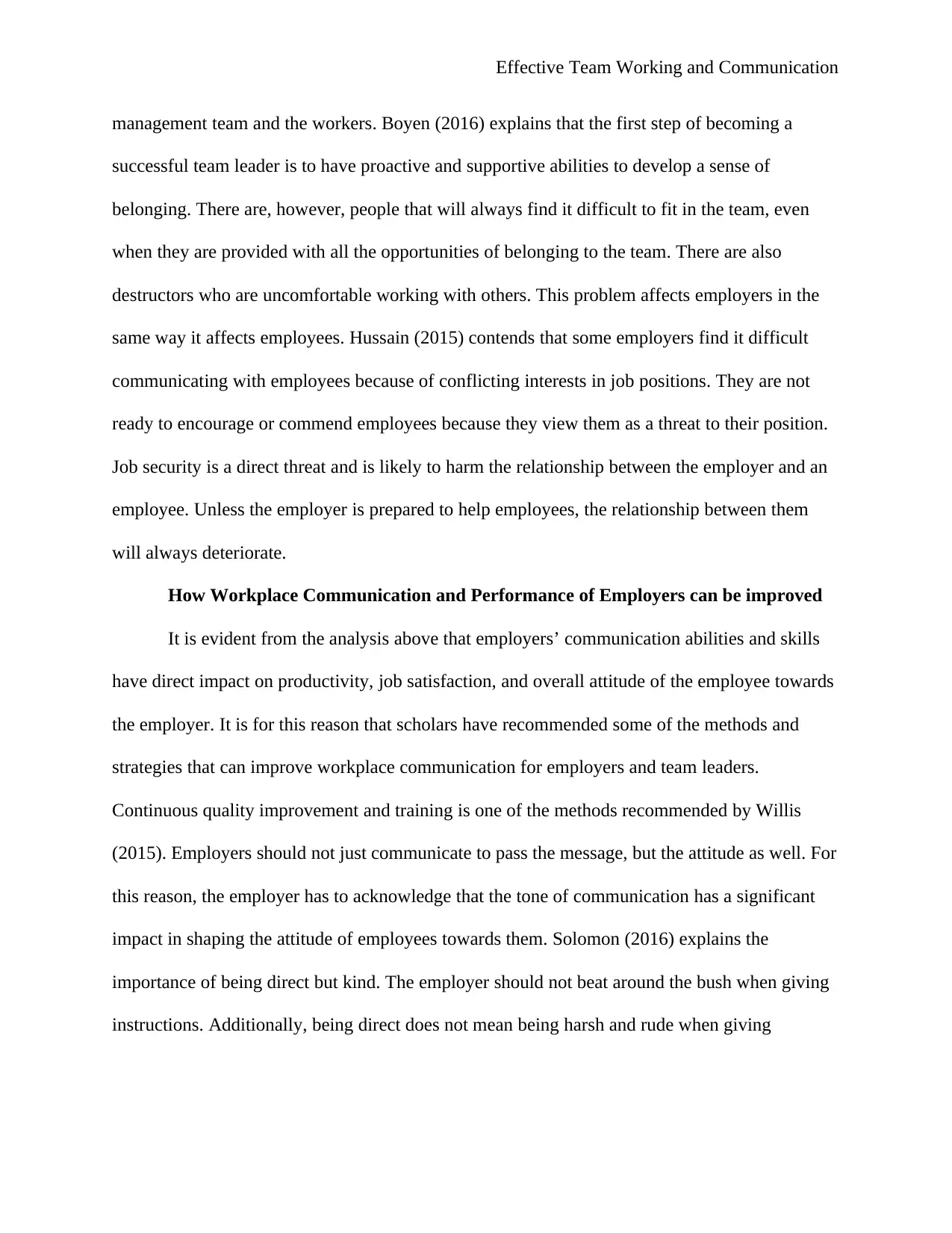
Effective Team Working and Communication
management team and the workers. Boyen (2016) explains that the first step of becoming a
successful team leader is to have proactive and supportive abilities to develop a sense of
belonging. There are, however, people that will always find it difficult to fit in the team, even
when they are provided with all the opportunities of belonging to the team. There are also
destructors who are uncomfortable working with others. This problem affects employers in the
same way it affects employees. Hussain (2015) contends that some employers find it difficult
communicating with employees because of conflicting interests in job positions. They are not
ready to encourage or commend employees because they view them as a threat to their position.
Job security is a direct threat and is likely to harm the relationship between the employer and an
employee. Unless the employer is prepared to help employees, the relationship between them
will always deteriorate.
How Workplace Communication and Performance of Employers can be improved
It is evident from the analysis above that employers’ communication abilities and skills
have direct impact on productivity, job satisfaction, and overall attitude of the employee towards
the employer. It is for this reason that scholars have recommended some of the methods and
strategies that can improve workplace communication for employers and team leaders.
Continuous quality improvement and training is one of the methods recommended by Willis
(2015). Employers should not just communicate to pass the message, but the attitude as well. For
this reason, the employer has to acknowledge that the tone of communication has a significant
impact in shaping the attitude of employees towards them. Solomon (2016) explains the
importance of being direct but kind. The employer should not beat around the bush when giving
instructions. Additionally, being direct does not mean being harsh and rude when giving
management team and the workers. Boyen (2016) explains that the first step of becoming a
successful team leader is to have proactive and supportive abilities to develop a sense of
belonging. There are, however, people that will always find it difficult to fit in the team, even
when they are provided with all the opportunities of belonging to the team. There are also
destructors who are uncomfortable working with others. This problem affects employers in the
same way it affects employees. Hussain (2015) contends that some employers find it difficult
communicating with employees because of conflicting interests in job positions. They are not
ready to encourage or commend employees because they view them as a threat to their position.
Job security is a direct threat and is likely to harm the relationship between the employer and an
employee. Unless the employer is prepared to help employees, the relationship between them
will always deteriorate.
How Workplace Communication and Performance of Employers can be improved
It is evident from the analysis above that employers’ communication abilities and skills
have direct impact on productivity, job satisfaction, and overall attitude of the employee towards
the employer. It is for this reason that scholars have recommended some of the methods and
strategies that can improve workplace communication for employers and team leaders.
Continuous quality improvement and training is one of the methods recommended by Willis
(2015). Employers should not just communicate to pass the message, but the attitude as well. For
this reason, the employer has to acknowledge that the tone of communication has a significant
impact in shaping the attitude of employees towards them. Solomon (2016) explains the
importance of being direct but kind. The employer should not beat around the bush when giving
instructions. Additionally, being direct does not mean being harsh and rude when giving
⊘ This is a preview!⊘
Do you want full access?
Subscribe today to unlock all pages.

Trusted by 1+ million students worldwide
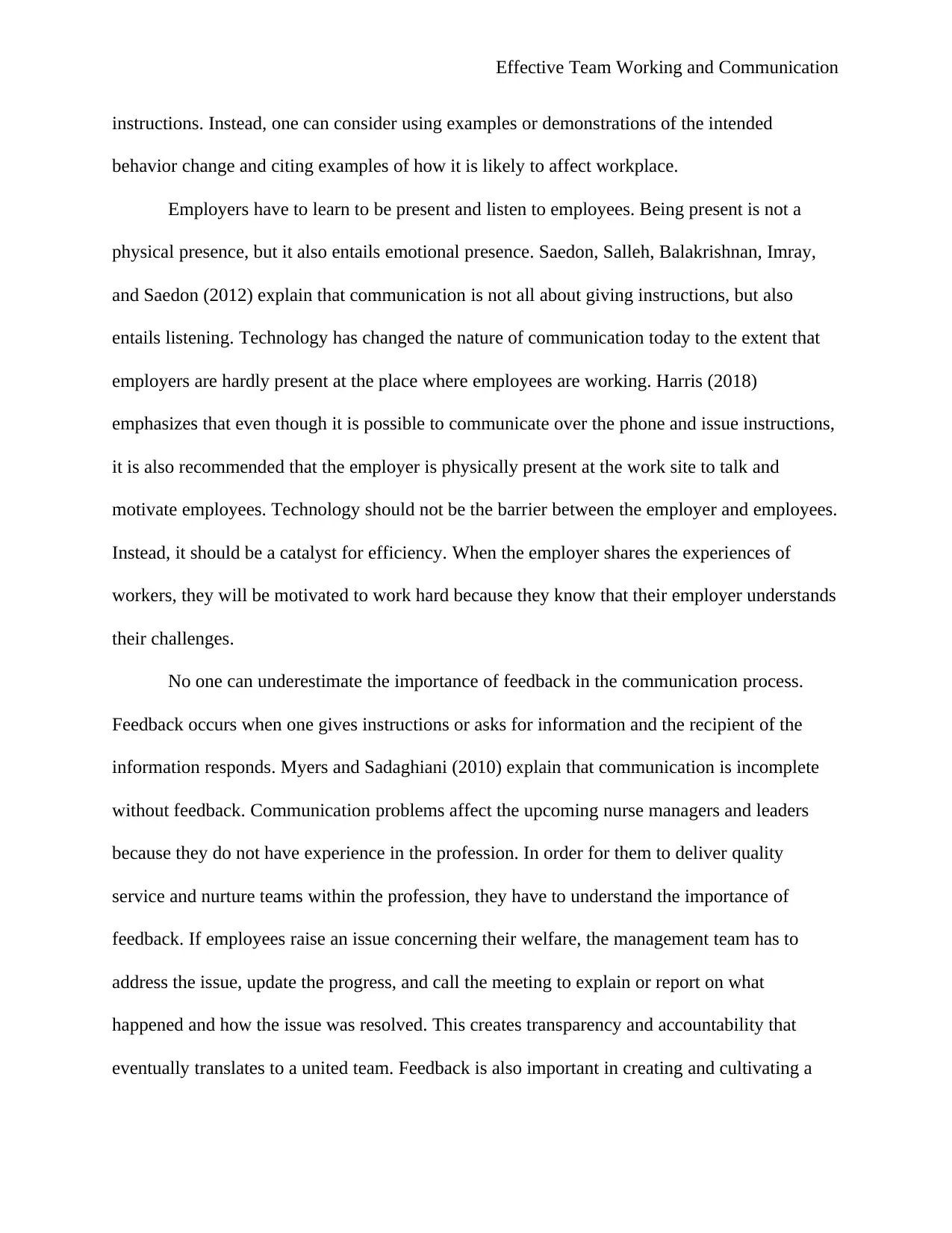
Effective Team Working and Communication
instructions. Instead, one can consider using examples or demonstrations of the intended
behavior change and citing examples of how it is likely to affect workplace.
Employers have to learn to be present and listen to employees. Being present is not a
physical presence, but it also entails emotional presence. Saedon, Salleh, Balakrishnan, Imray,
and Saedon (2012) explain that communication is not all about giving instructions, but also
entails listening. Technology has changed the nature of communication today to the extent that
employers are hardly present at the place where employees are working. Harris (2018)
emphasizes that even though it is possible to communicate over the phone and issue instructions,
it is also recommended that the employer is physically present at the work site to talk and
motivate employees. Technology should not be the barrier between the employer and employees.
Instead, it should be a catalyst for efficiency. When the employer shares the experiences of
workers, they will be motivated to work hard because they know that their employer understands
their challenges.
No one can underestimate the importance of feedback in the communication process.
Feedback occurs when one gives instructions or asks for information and the recipient of the
information responds. Myers and Sadaghiani (2010) explain that communication is incomplete
without feedback. Communication problems affect the upcoming nurse managers and leaders
because they do not have experience in the profession. In order for them to deliver quality
service and nurture teams within the profession, they have to understand the importance of
feedback. If employees raise an issue concerning their welfare, the management team has to
address the issue, update the progress, and call the meeting to explain or report on what
happened and how the issue was resolved. This creates transparency and accountability that
eventually translates to a united team. Feedback is also important in creating and cultivating a
instructions. Instead, one can consider using examples or demonstrations of the intended
behavior change and citing examples of how it is likely to affect workplace.
Employers have to learn to be present and listen to employees. Being present is not a
physical presence, but it also entails emotional presence. Saedon, Salleh, Balakrishnan, Imray,
and Saedon (2012) explain that communication is not all about giving instructions, but also
entails listening. Technology has changed the nature of communication today to the extent that
employers are hardly present at the place where employees are working. Harris (2018)
emphasizes that even though it is possible to communicate over the phone and issue instructions,
it is also recommended that the employer is physically present at the work site to talk and
motivate employees. Technology should not be the barrier between the employer and employees.
Instead, it should be a catalyst for efficiency. When the employer shares the experiences of
workers, they will be motivated to work hard because they know that their employer understands
their challenges.
No one can underestimate the importance of feedback in the communication process.
Feedback occurs when one gives instructions or asks for information and the recipient of the
information responds. Myers and Sadaghiani (2010) explain that communication is incomplete
without feedback. Communication problems affect the upcoming nurse managers and leaders
because they do not have experience in the profession. In order for them to deliver quality
service and nurture teams within the profession, they have to understand the importance of
feedback. If employees raise an issue concerning their welfare, the management team has to
address the issue, update the progress, and call the meeting to explain or report on what
happened and how the issue was resolved. This creates transparency and accountability that
eventually translates to a united team. Feedback is also important in creating and cultivating a
Paraphrase This Document
Need a fresh take? Get an instant paraphrase of this document with our AI Paraphraser
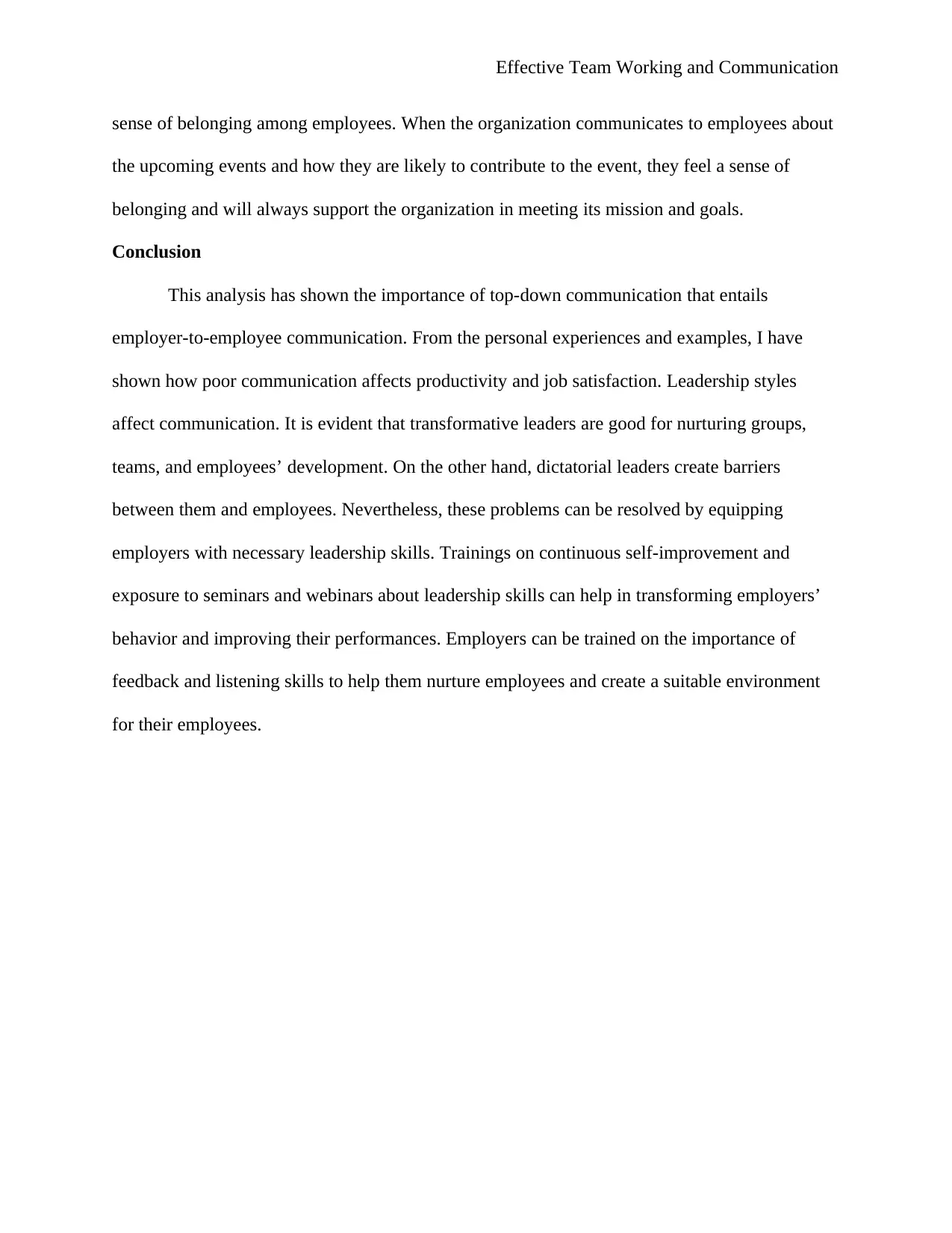
Effective Team Working and Communication
sense of belonging among employees. When the organization communicates to employees about
the upcoming events and how they are likely to contribute to the event, they feel a sense of
belonging and will always support the organization in meeting its mission and goals.
Conclusion
This analysis has shown the importance of top-down communication that entails
employer-to-employee communication. From the personal experiences and examples, I have
shown how poor communication affects productivity and job satisfaction. Leadership styles
affect communication. It is evident that transformative leaders are good for nurturing groups,
teams, and employees’ development. On the other hand, dictatorial leaders create barriers
between them and employees. Nevertheless, these problems can be resolved by equipping
employers with necessary leadership skills. Trainings on continuous self-improvement and
exposure to seminars and webinars about leadership skills can help in transforming employers’
behavior and improving their performances. Employers can be trained on the importance of
feedback and listening skills to help them nurture employees and create a suitable environment
for their employees.
sense of belonging among employees. When the organization communicates to employees about
the upcoming events and how they are likely to contribute to the event, they feel a sense of
belonging and will always support the organization in meeting its mission and goals.
Conclusion
This analysis has shown the importance of top-down communication that entails
employer-to-employee communication. From the personal experiences and examples, I have
shown how poor communication affects productivity and job satisfaction. Leadership styles
affect communication. It is evident that transformative leaders are good for nurturing groups,
teams, and employees’ development. On the other hand, dictatorial leaders create barriers
between them and employees. Nevertheless, these problems can be resolved by equipping
employers with necessary leadership skills. Trainings on continuous self-improvement and
exposure to seminars and webinars about leadership skills can help in transforming employers’
behavior and improving their performances. Employers can be trained on the importance of
feedback and listening skills to help them nurture employees and create a suitable environment
for their employees.

Effective Team Working and Communication
References
Bergman, C., Dellve, L., and Skagert, K. (2016). Exploring communication processes
in workplace meetings: A mixed methods study in a Swedish healthcare organization. Work
(Reading, Mass.), 54(3), 533–541. doi:10.3233/WOR-162366. [Online]. Available at:
https://www.ncbi.nlm.nih.gov/pmc/articles/PMC5147501/ (Accessed 06 April 2019)
Boyen, K. (2016). Teamwork. Mastering Soft Skills for Workplace Success. [Online]. Available
at: https://www.dol.gov/odep/topics/youth/softskills/teamwork.pdf (Accessed 06 April 2019)
Doyle, A. (2019). Communication skills for workplace success. The Balance. [Online].
Available at: https://www.thebalancecareers.com/communication-skills-list-2063779 (Accessed
06 April 2019)
Gervitis, A., and Eberhard, K. (2016).Team communication as a collaborative process. Frontiers
in Psychology. [Online]. Available at:
https://hrilab.tufts.edu/publications/gervitsetal2016frontiers.pdf. (Accessed 06 April 2019)
Harris, K. (2018). Managing organizational communication. SHRM. [Online]. Available at:
https://www.shrm.org/resourcesandtools/tools-and-samples/toolkits/pages/
managingorganizationalcommunication.aspx (Accessed 06 April 2019)
Hussain, Z. (2015). Effective communication brings successful organizational change. [Online].
Available at: http://www.abrmr.com/myfile/conference_proceedings/Con_Pro_12315/7-
dubai13.pdf (Accessed 06 April 2019)
Levin, M. (2016). ‘Nine leadership behaviors that lose employee trust and respect.’ Available at:
https://www.inc.com/marissa-levin/9-leadership-behaviors-that-lose-employee-trust-and-
respect.html (Accessed 06 April 2019)
References
Bergman, C., Dellve, L., and Skagert, K. (2016). Exploring communication processes
in workplace meetings: A mixed methods study in a Swedish healthcare organization. Work
(Reading, Mass.), 54(3), 533–541. doi:10.3233/WOR-162366. [Online]. Available at:
https://www.ncbi.nlm.nih.gov/pmc/articles/PMC5147501/ (Accessed 06 April 2019)
Boyen, K. (2016). Teamwork. Mastering Soft Skills for Workplace Success. [Online]. Available
at: https://www.dol.gov/odep/topics/youth/softskills/teamwork.pdf (Accessed 06 April 2019)
Doyle, A. (2019). Communication skills for workplace success. The Balance. [Online].
Available at: https://www.thebalancecareers.com/communication-skills-list-2063779 (Accessed
06 April 2019)
Gervitis, A., and Eberhard, K. (2016).Team communication as a collaborative process. Frontiers
in Psychology. [Online]. Available at:
https://hrilab.tufts.edu/publications/gervitsetal2016frontiers.pdf. (Accessed 06 April 2019)
Harris, K. (2018). Managing organizational communication. SHRM. [Online]. Available at:
https://www.shrm.org/resourcesandtools/tools-and-samples/toolkits/pages/
managingorganizationalcommunication.aspx (Accessed 06 April 2019)
Hussain, Z. (2015). Effective communication brings successful organizational change. [Online].
Available at: http://www.abrmr.com/myfile/conference_proceedings/Con_Pro_12315/7-
dubai13.pdf (Accessed 06 April 2019)
Levin, M. (2016). ‘Nine leadership behaviors that lose employee trust and respect.’ Available at:
https://www.inc.com/marissa-levin/9-leadership-behaviors-that-lose-employee-trust-and-
respect.html (Accessed 06 April 2019)
⊘ This is a preview!⊘
Do you want full access?
Subscribe today to unlock all pages.

Trusted by 1+ million students worldwide
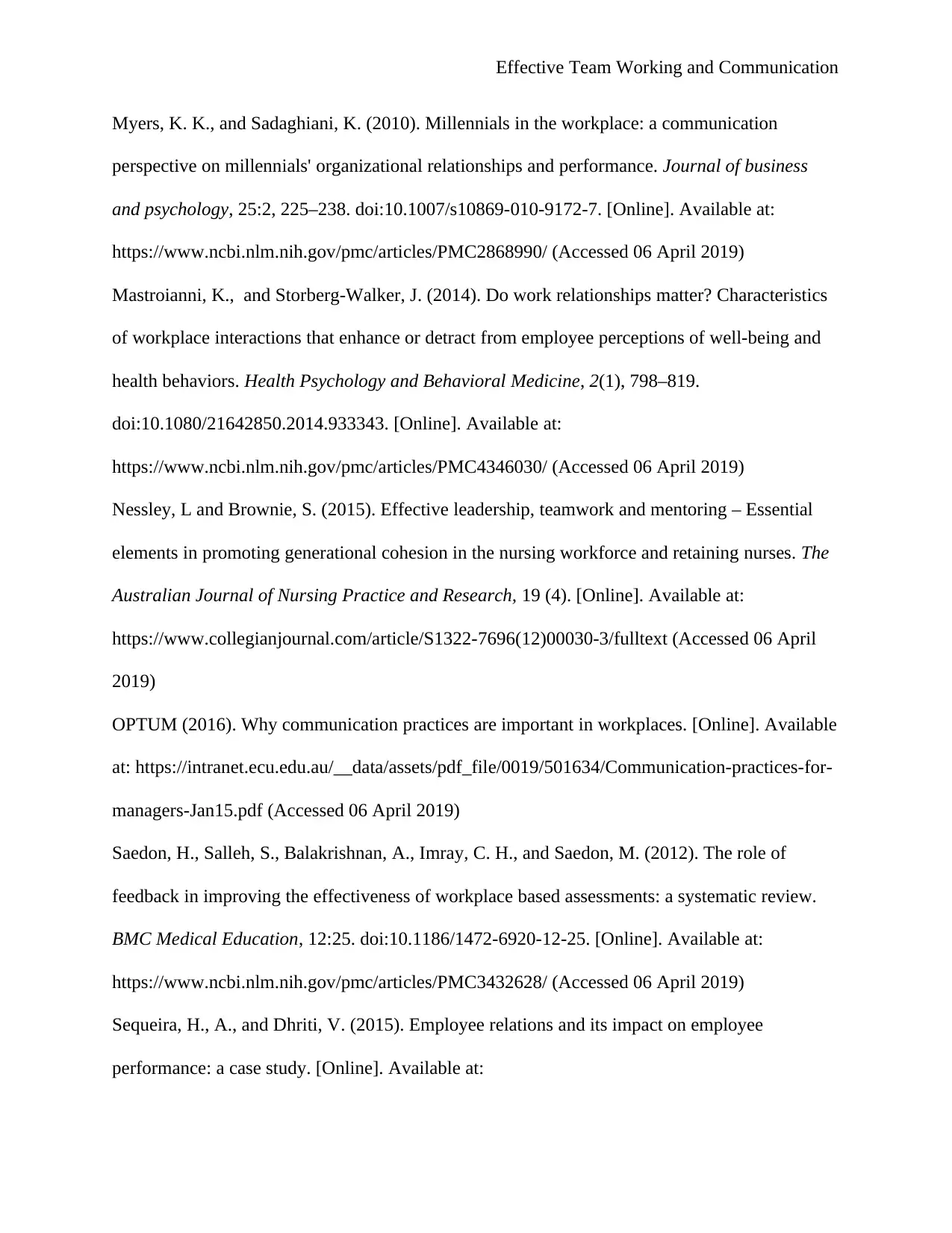
Effective Team Working and Communication
Myers, K. K., and Sadaghiani, K. (2010). Millennials in the workplace: a communication
perspective on millennials' organizational relationships and performance. Journal of business
and psychology, 25:2, 225–238. doi:10.1007/s10869-010-9172-7. [Online]. Available at:
https://www.ncbi.nlm.nih.gov/pmc/articles/PMC2868990/ (Accessed 06 April 2019)
Mastroianni, K., and Storberg-Walker, J. (2014). Do work relationships matter? Characteristics
of workplace interactions that enhance or detract from employee perceptions of well-being and
health behaviors. Health Psychology and Behavioral Medicine, 2(1), 798–819.
doi:10.1080/21642850.2014.933343. [Online]. Available at:
https://www.ncbi.nlm.nih.gov/pmc/articles/PMC4346030/ (Accessed 06 April 2019)
Nessley, L and Brownie, S. (2015). Effective leadership, teamwork and mentoring – Essential
elements in promoting generational cohesion in the nursing workforce and retaining nurses. The
Australian Journal of Nursing Practice and Research, 19 (4). [Online]. Available at:
https://www.collegianjournal.com/article/S1322-7696(12)00030-3/fulltext (Accessed 06 April
2019)
OPTUM (2016). Why communication practices are important in workplaces. [Online]. Available
at: https://intranet.ecu.edu.au/__data/assets/pdf_file/0019/501634/Communication-practices-for-
managers-Jan15.pdf (Accessed 06 April 2019)
Saedon, H., Salleh, S., Balakrishnan, A., Imray, C. H., and Saedon, M. (2012). The role of
feedback in improving the effectiveness of workplace based assessments: a systematic review.
BMC Medical Education, 12:25. doi:10.1186/1472-6920-12-25. [Online]. Available at:
https://www.ncbi.nlm.nih.gov/pmc/articles/PMC3432628/ (Accessed 06 April 2019)
Sequeira, H., A., and Dhriti, V. (2015). Employee relations and its impact on employee
performance: a case study. [Online]. Available at:
Myers, K. K., and Sadaghiani, K. (2010). Millennials in the workplace: a communication
perspective on millennials' organizational relationships and performance. Journal of business
and psychology, 25:2, 225–238. doi:10.1007/s10869-010-9172-7. [Online]. Available at:
https://www.ncbi.nlm.nih.gov/pmc/articles/PMC2868990/ (Accessed 06 April 2019)
Mastroianni, K., and Storberg-Walker, J. (2014). Do work relationships matter? Characteristics
of workplace interactions that enhance or detract from employee perceptions of well-being and
health behaviors. Health Psychology and Behavioral Medicine, 2(1), 798–819.
doi:10.1080/21642850.2014.933343. [Online]. Available at:
https://www.ncbi.nlm.nih.gov/pmc/articles/PMC4346030/ (Accessed 06 April 2019)
Nessley, L and Brownie, S. (2015). Effective leadership, teamwork and mentoring – Essential
elements in promoting generational cohesion in the nursing workforce and retaining nurses. The
Australian Journal of Nursing Practice and Research, 19 (4). [Online]. Available at:
https://www.collegianjournal.com/article/S1322-7696(12)00030-3/fulltext (Accessed 06 April
2019)
OPTUM (2016). Why communication practices are important in workplaces. [Online]. Available
at: https://intranet.ecu.edu.au/__data/assets/pdf_file/0019/501634/Communication-practices-for-
managers-Jan15.pdf (Accessed 06 April 2019)
Saedon, H., Salleh, S., Balakrishnan, A., Imray, C. H., and Saedon, M. (2012). The role of
feedback in improving the effectiveness of workplace based assessments: a systematic review.
BMC Medical Education, 12:25. doi:10.1186/1472-6920-12-25. [Online]. Available at:
https://www.ncbi.nlm.nih.gov/pmc/articles/PMC3432628/ (Accessed 06 April 2019)
Sequeira, H., A., and Dhriti, V. (2015). Employee relations and its impact on employee
performance: a case study. [Online]. Available at:
Paraphrase This Document
Need a fresh take? Get an instant paraphrase of this document with our AI Paraphraser
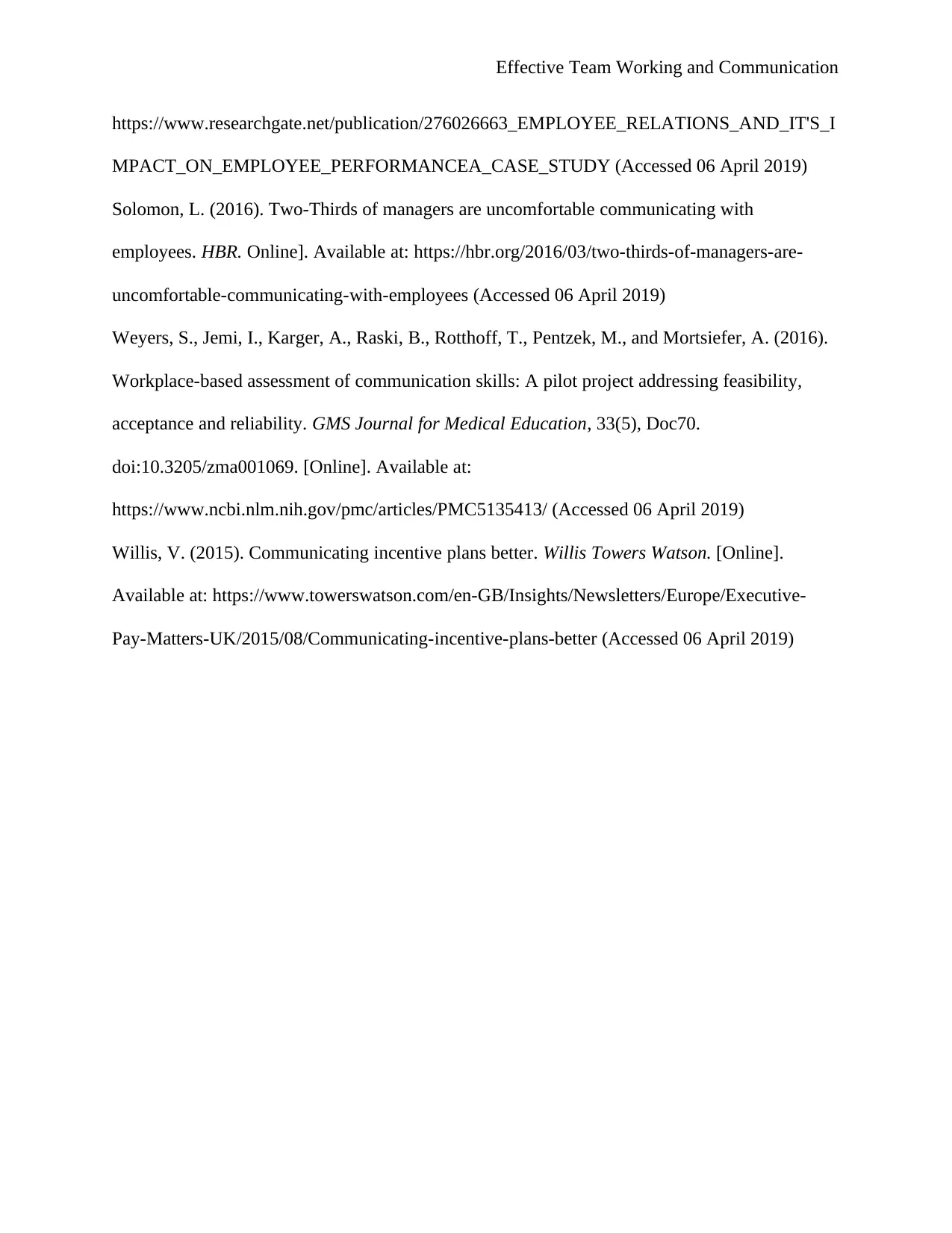
Effective Team Working and Communication
https://www.researchgate.net/publication/276026663_EMPLOYEE_RELATIONS_AND_IT'S_I
MPACT_ON_EMPLOYEE_PERFORMANCEA_CASE_STUDY (Accessed 06 April 2019)
Solomon, L. (2016). Two-Thirds of managers are uncomfortable communicating with
employees. HBR. Online]. Available at: https://hbr.org/2016/03/two-thirds-of-managers-are-
uncomfortable-communicating-with-employees (Accessed 06 April 2019)
Weyers, S., Jemi, I., Karger, A., Raski, B., Rotthoff, T., Pentzek, M., and Mortsiefer, A. (2016).
Workplace-based assessment of communication skills: A pilot project addressing feasibility,
acceptance and reliability. GMS Journal for Medical Education, 33(5), Doc70.
doi:10.3205/zma001069. [Online]. Available at:
https://www.ncbi.nlm.nih.gov/pmc/articles/PMC5135413/ (Accessed 06 April 2019)
Willis, V. (2015). Communicating incentive plans better. Willis Towers Watson. [Online].
Available at: https://www.towerswatson.com/en-GB/Insights/Newsletters/Europe/Executive-
Pay-Matters-UK/2015/08/Communicating-incentive-plans-better (Accessed 06 April 2019)
https://www.researchgate.net/publication/276026663_EMPLOYEE_RELATIONS_AND_IT'S_I
MPACT_ON_EMPLOYEE_PERFORMANCEA_CASE_STUDY (Accessed 06 April 2019)
Solomon, L. (2016). Two-Thirds of managers are uncomfortable communicating with
employees. HBR. Online]. Available at: https://hbr.org/2016/03/two-thirds-of-managers-are-
uncomfortable-communicating-with-employees (Accessed 06 April 2019)
Weyers, S., Jemi, I., Karger, A., Raski, B., Rotthoff, T., Pentzek, M., and Mortsiefer, A. (2016).
Workplace-based assessment of communication skills: A pilot project addressing feasibility,
acceptance and reliability. GMS Journal for Medical Education, 33(5), Doc70.
doi:10.3205/zma001069. [Online]. Available at:
https://www.ncbi.nlm.nih.gov/pmc/articles/PMC5135413/ (Accessed 06 April 2019)
Willis, V. (2015). Communicating incentive plans better. Willis Towers Watson. [Online].
Available at: https://www.towerswatson.com/en-GB/Insights/Newsletters/Europe/Executive-
Pay-Matters-UK/2015/08/Communicating-incentive-plans-better (Accessed 06 April 2019)
1 out of 11
Related Documents
Your All-in-One AI-Powered Toolkit for Academic Success.
+13062052269
info@desklib.com
Available 24*7 on WhatsApp / Email
![[object Object]](/_next/static/media/star-bottom.7253800d.svg)
Unlock your academic potential
Copyright © 2020–2025 A2Z Services. All Rights Reserved. Developed and managed by ZUCOL.





